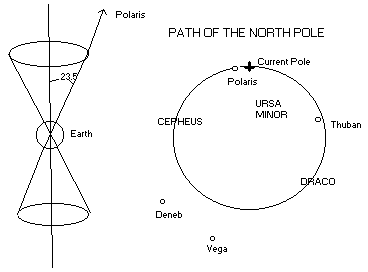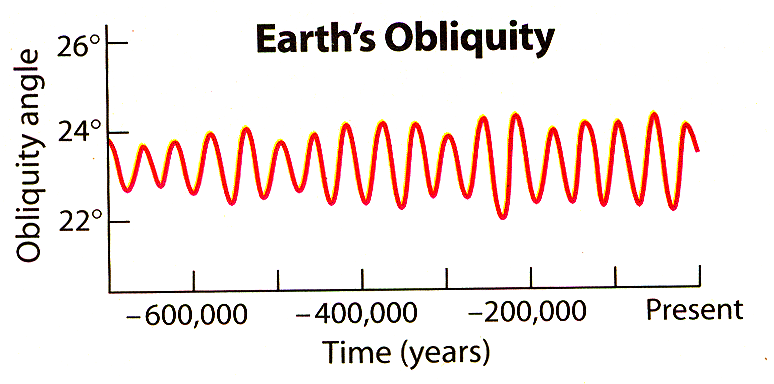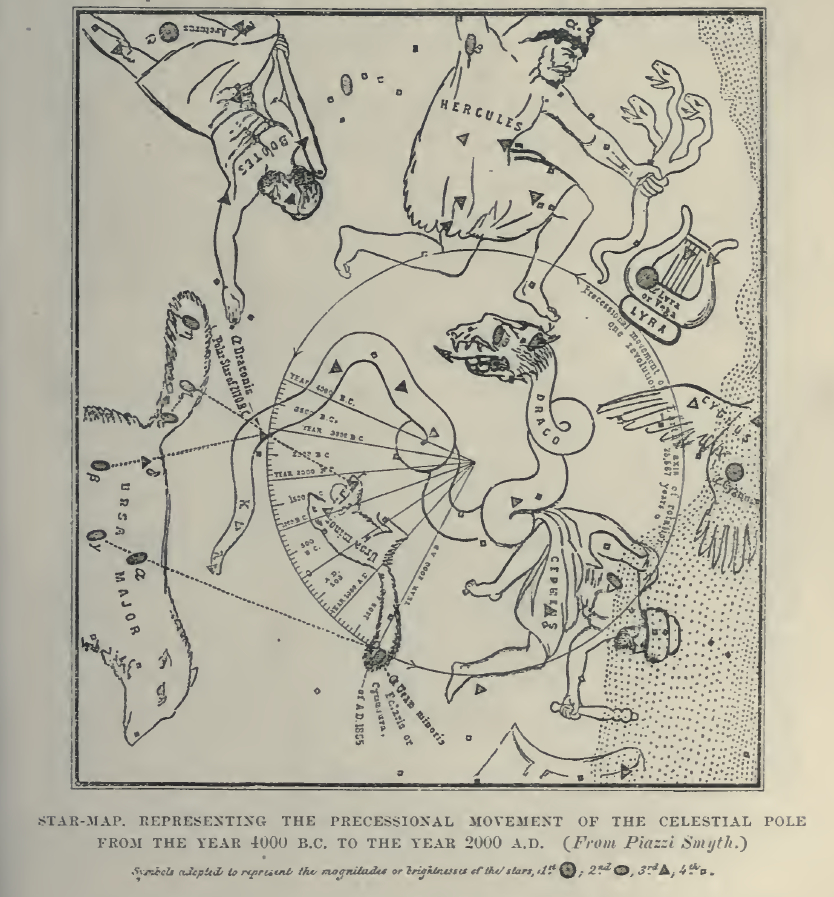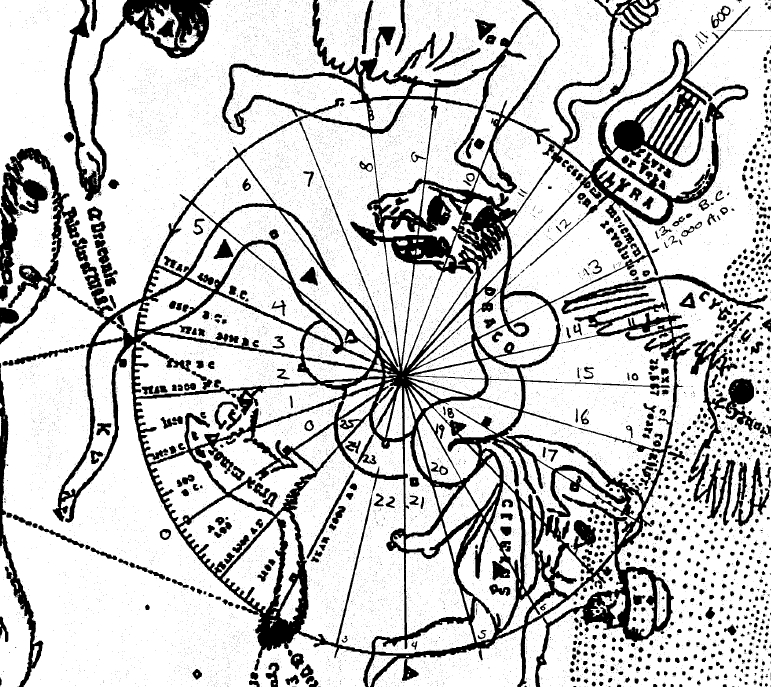|
Piazzi Smyth We are in search of VEGA remember. Reader, continue the scale back, from 4000 B.C. to 12,098 B.C. - 13,465 B.C. I guess ~11,600 B.C. for Vega to "center" itself. Close enough to be the Pole Star of the Ancients. So, the ~13,000 B.C. build date of the Great Pyramid, is accurate. Nice work Edward, nice work. The LORD has directed the Hiddekelic's to build the altar just prior to their destruction - part of the grand plan of redemption. The Pole Star was moving from Cygnus to Vega.
29,789 B.C., the first creation of man, the pole star was Alpha Draconis,
(and was again about 2170 B.C., which matches markings on this original chart, and in the main entrance tunnel of the pyramid.)
23,017 B.C., the second creation of man, the pole star was Polaris. 13,465 B.C., the third creation of man, the pole star was half way between Cygnus and Vega. 3,897 B.C., the fourth creation of man, the pole star was approaching Alpha Draconis again. The wheel keeps rotating until we reach Alpha Draconis, have we come full circle? ...with only a thin slice of "time" left to what end? 33,560 years ago, the pole star is pointing straight up on this chart, but to what? Time to get the star charts out.
If you notice, looking back at 3853 A.D. the
final demise of aggregate matter, it lines up with 21,414 B.C.
or close at 3586
A.D. the Euphratic 1st Age
"the white race
destruction", with only a
267 year variance. Take notice please to the Dates. . . . .
A Word from J. Norman Lockyer 1894
"In the last chapter I referred to one of the difficulties (See Chap. xii.
"Dawn of
Astronomy" Lockyer 1894.) of modern inquiries into the
orientation of ancient temples, which arises from the fact that the sun has not
always, at the solstices, risen or set at exactly the same points of the
horizon. We now find ourselves face to face with the fact that the stars do not
rise or set at the same points century after century. We saw that the change in
the position of the sun on the horizon at the solstices is due to a very small
change of obliquity of the ecliptic, so that in a matter of something like 6,000
years the position of the sun at sunrise and sunset on the horizon may be varied
by, roughly speaking, 1 degree. But in the case of the stars the matter is very
much more serious, because in the course of something like 13,000 years the -
rising or setting - places of a star may vary by something like 47° along the
horizon north or south.
It is now a recognised principle that there is, so to speak, a wobble of the
earth's axis round the pole of the heavens, in consequence of the attraction of
the sun on the nearer point of this equatorial ring being greater than on the
part of the ring further removed from it. That processional movement is not
quite so simple as it is shown by the model, because what the sun does in this
way is done to a very much larger extent by the moon, the moon being so very
much nearer to us. Among other important results of these movements dependent upon precession we have the various changes in the polestar from period to period, due to the various positions occupied by the pole of the earth's equator. We thus see how in this period of 25,000 years or thereabouts the pole-stars will change, for a pole-star is merely the star near the pole of the equator for the time being. At present, as we all know, the pole-star is in the constellation Ursa Minor. During the last' 25,000 years the pole-stars have been those lying nearest to a curved line struck from the pole of the heavens with a radius equal to the obliquity of the ecliptic, which, as we have seen, is liable to change within small limits; so that about 10,000 or 12,000 years ago the pole-star was no longer the little star in Ursa Minor that we all know, but the bright star Vega, in the constellation Lyra. Of course 25,000 years ago the pole-star was practically the same as it is at present. Associated with this change in the pole-star, the point of intersection of the two fundamental planes (the plane of the earth's rotation and the plane of the earth's revolution) will be liable to change, and the period will be the same—about 25,000 years. Where these two planes cut each other we have the equinoxes, because the intersection of the planes defines for us the vernal and the autumnal equinoxes; when the sun is highest and lowest half-way between these points we have the solstices. In a period of 25,000 years the star which is nearest to an equinox will return to it, and that which is nearest a solstice will return to it. During the period there will be a constant change of stars marking the equinoxes and the solstices.
The chief points in the sun's yearly path then will change among the stars in
consequence of this precession. It is perfectly clear that if we have a means of
calculating back the old positions of stars, and if we have any very old
observations, we can help matters very much, because the old observations if
they were accurately made would tell us that such and such a star rose with the
sun at the solstice or at the equinox at some special point of ancient time. If
it be possible to calculate the time at which the star occupied that position
with regard to the sun, we have an astronomical means of determining the time,
within a few years, at which that particular observation was made. . . . .
And, an Astronomy Lesson from Worthy: "The phenomenon we call "precession" was discovered by Greek astronomer Hipparchus when he compared his own circa 200 BC records with older charts. What he saw was that the equinoxes in his day (where the sun's path crosses the celestial equator) were in a different position among the stars than the 150-year-old comparison charts showed. This is due to a gyroscopic wobble of earth's spin axis that takes 26000 years to complete. In this wobble motion, the tilt of the earth stays roughly constant at 23.4 degrees but the orientation is always changing.  One consequence of precession is that the north star Polaris is drifting. It is only "north star" by coincidence today. Vega will be our north star for a time in the distant future. Another consequence is that precession introduces a difference between a sidereal (real) year and a tropical (by the sun) year because during the course of one year the position of the equinox changes slightly. The physical cause of the precession is a torque (twisting) of the earth, caused mostly by the sun's and the moon's gravity pulling on the equatorial bulges of the earth. If earth were NOT spinning, the sun and moon would pull the earth so that the bulges were flat in the sun-earth orbital plane. The planets have some gravitational influence also, but insignificant compared to the sun and moon. Still, the planets manage to cause the orbit of earth about the sun to precess and morph. The inclination of Earth's orbit varies with respect to the solar system's invariant plane with a period of roughly 71000 years. Apsidal (Earth's orbit's major axis) precession P = 112,000 yr, combines with the 25,770 yr precession to make it about 21,630 years for the Vernal Equinox to cycle 360 degrees. Planetary perturbations also cause an oscillation in the ellipticity of earth's orbit whose main component 413,000 year long, in which the eccentricity varies from its mean of 0.0019 by +/- 0.012. Taken in conjunction with the 26000-year spin-axis precession, the 71000-year orbit precession causes a 41000-year oscillation in the tilt of the earths axis, about plus or minus 1.3 degrees from its average value of 23.3 degrees. This number is not absolutely stable - it depends on the combined positions of all the planets through time. The obliquity (tilt) for the last 600,000 years is shown below.  The tilt reached a maximum of 24.2 degrees about 9500 years ago, and has been decreasing ever since. The tilt is now near the average value, but the rate of change of the obliquity is near a maximum. The most startling consequence of this is that the tropics (the tropics of Cancer and Capricorn, where the most northerly or southerly vertical rays of the sun strike) are moving toward the equator. The rate is more than 14 meters per year! Example: the government of Taiwan erected a monument in a park marking the tropic in 1908. The actual tropic is now more than a kilometer south of this location! The arctic circles are likewise travelling toward their respective poles. The temperate zones gain 1550 square kilometers of territory every year! Another consequence may be seen in climactic data from oxygen isotope data: there a appears to be a cyclic climate pattern with a 41,000-year period, one of the so-called Milankovitch cycles. This can be qualitatively understood: when the obliquity is low, the polar regions get less sunlight, cool, and accumulate ice and snow. The total amount of sunlight caught by the earth remains the same, so it is premature to positively identify obliquity changes as the root cause of the ice ages." Worthy 2000.
//∞\\
|


